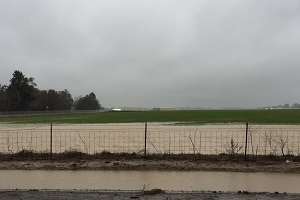When are seasonal heavy rains welcomed but worrisome? When rains fill reservoirs, but also turn fields into seas of standing water!

Such has been the case in northern California which has seen torrential rains in recent weeks. After 5 years of intensive drought, the 2016-2017 rains are a welcome relief, but pose a danger to many crops including alfalfa.
It seems strange that we're discussing water damage a few months after discussing (lack of) water stress!
Ah, the ups and downs of agriculture!
WHAT ARE THE MECHANISMS FOR FLOOD DAMAGE?
Alfalfa grown in Mediterranean and desert climates is still alive, green and growing during winter periods and thus subject to water damage during floods. This is unlike colder regions where alfalfa is very dormant and brown during winter months (but damage can occur in those areas as well).
The extent of either death or damage depends upon temperature, drainage, alfalfa growth status (young vs. old, active vs. dormant), and duration of flooding. The mechanisms for damage include:
- Lack of Oxygen—Alfalfa roots must ‘breath' just like humans, and respiration is reduced under waterlogging. If severe, lack of oxygen can cause death or lots of damage.
- Temperature—Damage is greater under warm temperatures vs. cold due to increases in respiration rates (in plants and soil microorganisms). Hot temperatures can kill alfalfa within hours, but the crop can survive for days under cold temperatures.
- Death of fine root hairs—Fine root hairs are particularly damaged during waterlogging and must be regenerated later if the plants survive. These are critical for nutrient and water uptake later.
- Root Pruning. Saturated sub-surface layers can cause root pruning below that level (e.g. root pruning at 12” plow pans). These roots may recover but are damaged.
- Micronutrient availability –Under reducing conditions (low oxygen), iron and other micronutrients may become unavailable for plant growth due to excess bicarbonates or other mechanisms including root damage.
- Disease and pests—Since saturated soil conditions favor disease organisms, Phytophora, nematodes, and other organisms can gain the upper hand over a weakened alfalfa plant.
- Weeds—Aggressive cold-favoring, flood-tolerant winter weeds can completely dominate alfalfa stands weakened by flooding.
- Nodules— The Rhizobium nodules are weakened or damaged under flooded conditions, resulting in reduced nitrogen fixation.
How long does it take to do damage?
This will depend upon variety, temperature and soil drainage characteristics. Dormant varieties under cold conditions may tolerate some submersion for several days; actively growing plants less so. Sometimes it could be months before damage is noticed.
We expect greater damage during late spring flooding vs. January flooding. Winter flooding causes less damage due to the plants slower physiological processes. Also, moving water is less harmful than standing water, containing more oxygen. Soils that rapidly drain after flooding exhibit less crop damage. Drainage limitations may affect plants many months after flooding occurred.
WHAT TO DO? WHAT NOT TO DO?
After the intense flooding, when fields have drained, inspect roots and crowns for damage caused by anaerobic (without oxygen) conditions in the soil. Dig up roots and examine their health. Do you see greater disease in crowns or center of roots? Roots that are soft and compress easily when squeezed may be damaged beyond hope. If roots are beginning to release a strong odor, they likely won't recover. If roots are white, they may Assess your stand-if the plants recover, will you have an adequate stand? Dig up roots and see if soil impediments have caused greater damage 12-16” below the surface (root pruning). Keep an eye on the plants, inspecting for damage and yield throughout the following summer; sometimes disease development is delayed with weakened plants succumbing to damage months later.
Seedling Fields. Newly-seeded fields, especially those seeded late in the previous fall, are the most susceptible to damage from saturated soil conditions. Seedling alfalfa has small weak roots which can die quickly from oxygen deprivation. Seedling plants are also much more susceptible to diseases such as Phytophora and Pythium.
Ideas for flood-damaged seedling fields: